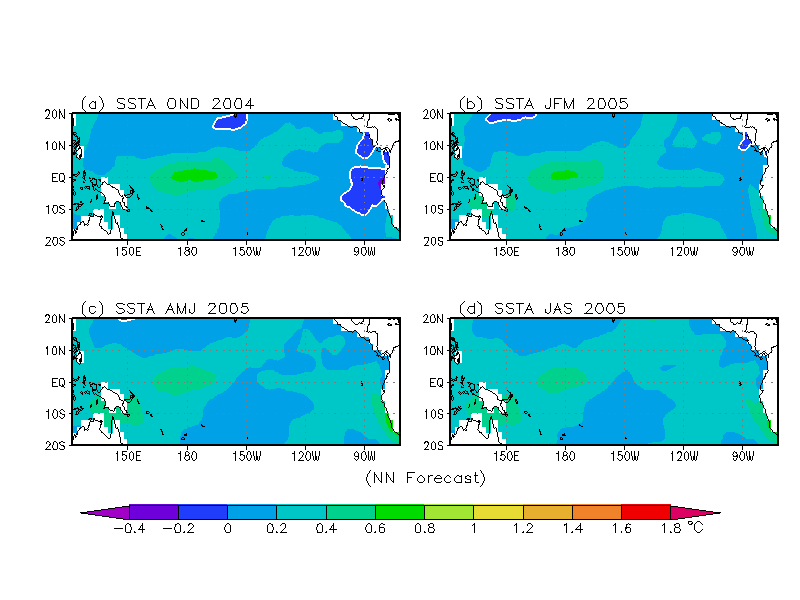Neural network forecasts of the tropical Pacific sea surface temperatures
Aiming Wu, William W. Hsieh and Benyang Tang
A neural network (NN) model had been used by our group to predict the
SST anomalies in the Nino3.4 region in the equatorial Pacific (Tang et
al, 2000). A
new NN model has been built to forecast the SST anomalies
over the entire tropical Pacific.
Click here to see details about this model.
Using sea level pressure and sea surface temperature data up to the end of
August, 2004,
forecasts were made with the
NN model. Ensemble-averaged forecasts for the sea surface temperature
anomalies (SSTA) in the Nino3.4 region
at various lead times are shown in Fig.1, showing near-normal to
slightly warm conditions
in late 2004 to early 2005. The forecasted SSTA
fields over the tropical Pacific are shown in Fig.2.
Figure 1. The SSTA (in degree Celsius) in the Nino3.4
area (170W-120W,5S-5N) predicted by the ensemble-averaged nonlinear
model at 3, 6, 9 and 12 months of lead time (circles), with
observations denoted by the solid line. Tick marks along the abscissa
indicate the January of the given years.
(The postscript file of Fig.1 is also available).

Figure 2. SSTA (in ºC) predicted by the ensemble-averaged
nonlinear model at 3, 6, 9 and 12 months of lead time, corresponding to
the four consecutive seasons starting with
OND (October - December, 2004).
The zero contour is shown as a white curve.
(The postscript file of Fig.2 is also available).
 Data in tabular format for the Nino3.4 SSTA (in ºC) at 3, 6, 9 and
12 months of lead time:
Data in tabular format for the Nino3.4 SSTA (in ºC) at 3, 6, 9 and
12 months of lead time:
| OND | 2004 | 0.32 |
| JFM | 2005 | 0.28 |
| AMJ | 2005 | 0.22 |
| JAS | 2005 | 0.23 |
Reference
Tang, B., W.W. Hsieh, A.H. Monahan and F.T. Tangang, 2000. Skill
comparisons between neural networks and canonical correlation analysis
in predicting the equatorial Pacific sea surface temperatures.
J.Climate, 13: 287-293.
Back to [UBC Climate
Prediction Group Home Page]


